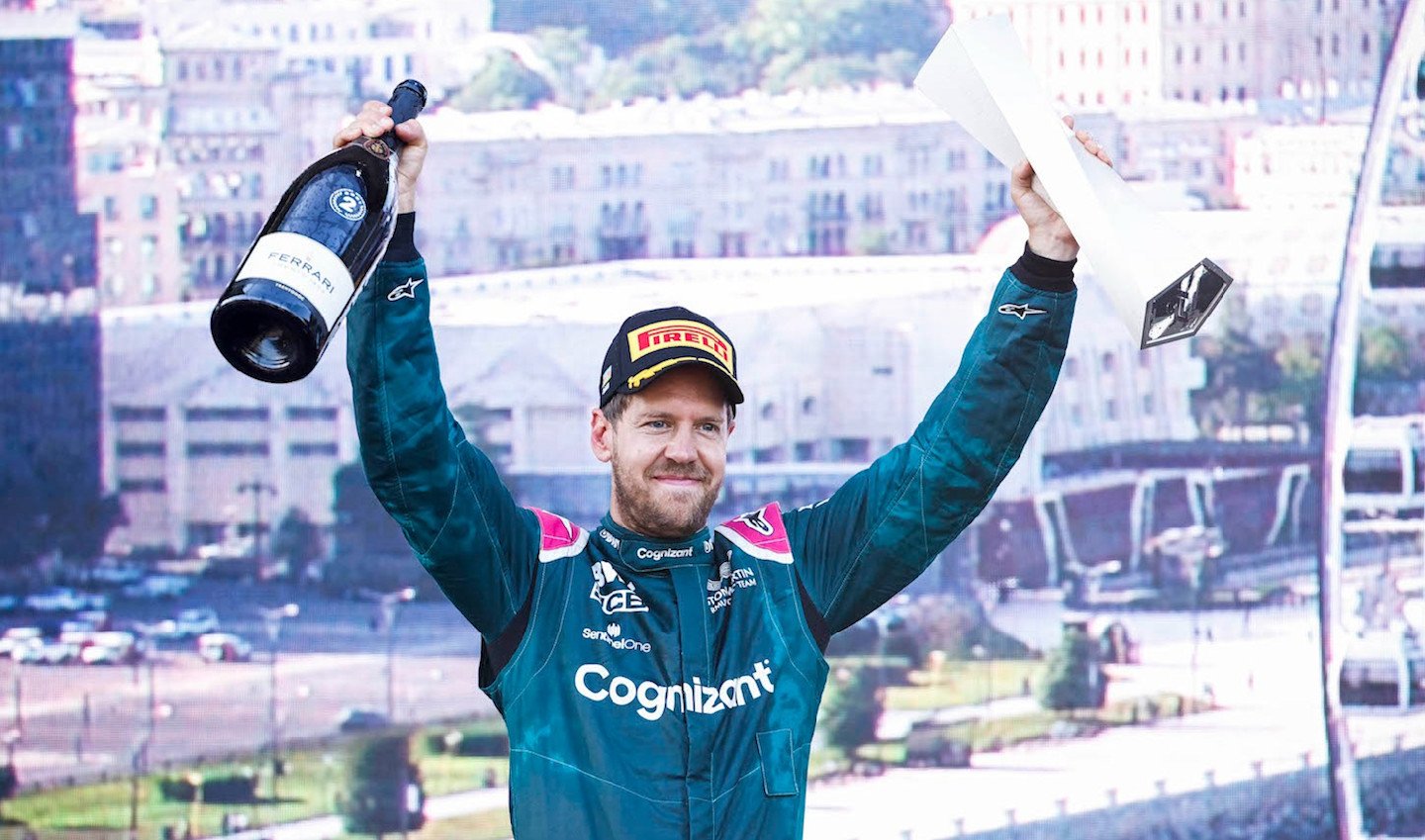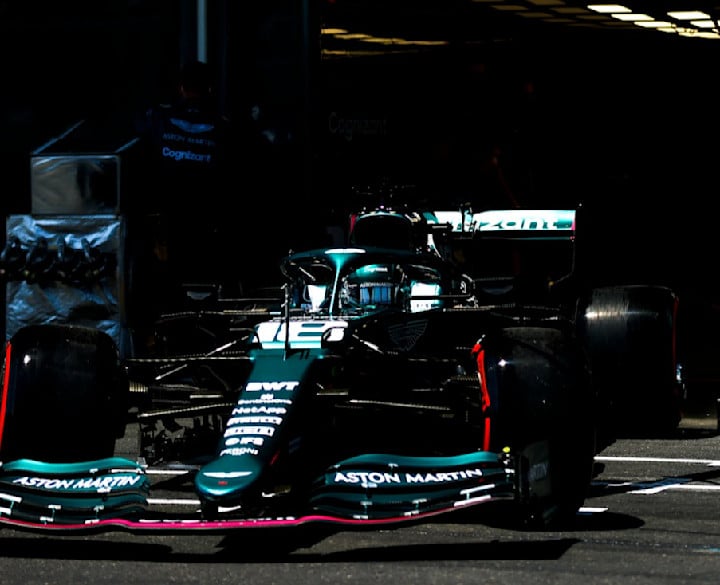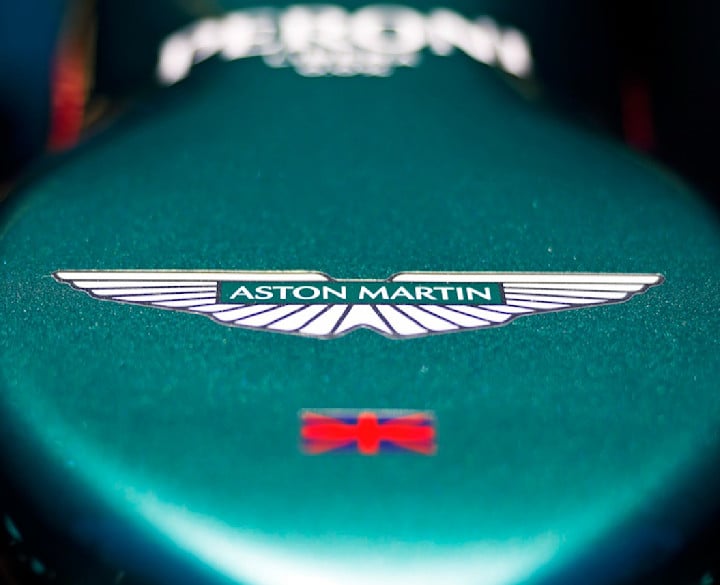AzerbaijanAzerbaijan
2021 season


The first Formula One World Championship podium in Aston Martin's history. Aston Martin Cognizant Formula One™ Team rose above the chaos in Baku. A beautiful drive from Sebastian Vettel, combined with the expertise of the pitwall, delivered second in the Azerbaijan Grand Prix. Lance Stroll drove a superb recovery drive until a technical problem robbed the Canadian of points through no fault of his own.

I felt good in the car, and combined with on-track events and strategy, we were able to get a really special result.
Sebastian's review
"I am over the moon and P2 means a great deal to all of us. We did not expect to be on the podium, but we made great progress through the weekend, and the car had strong race pace. Yesterday was challenging [due to the red flag in qualifying], but I was relaxed and confident going into the race. The key was being able to start with a free choice of tyres in P11. It meant we could use a new set of softs to make up two places at the start and then run longer to overcut Yuki [Tsunoda]. It gave us a platform for the second half of the race and put us in a position to take advantage. I felt good in the car, and combined with on-track events and strategy, we were able to get a really special result."


There are positives to take, especially our race pace, and, of course, the podium for Sebastian.
Lance's review
"I am frustrated not to finish the race, but I am OK. We were on course to score good points by running much longer before the pit stops and overcutting a lot of cars. That proved it was the right call to start on the hard tyres because we had good pace throughout the first stint and the race was coming to us. I am not sure what happened to cause me to spin on the straight because there was no sign of any issues, so we need to investigate. It has been a challenging weekend for me, but there are positives to take, especially our race pace, and, of course, the podium for Sebastian. Huge congratulations to the whole team."


A brilliant result for everyone in our team and the first ever podium for Aston Martin.
Otmar's review
“Lance suffered a DNF through no fault of his own, having made very impressive progress in the early laps. He was soon running in the points, making the overcut strategy work well, and was driving superbly on hard tyres when it all came to an end for him in a spectacular way on lap 31. We are investigating the cause of the accident, together with Pirelli. Sebastian also drove extremely well, making up two places on lap one, running a long stint on soft tyres and thereby jumping [Yuki] Tsunoda during the pit stops, and holding seventh place at the halfway point. Then, when Lance was very sadly eliminated, Sebastian moved up to sixth. He then nailed the Safety Car restart, duly passing Charles [Leclerc] for fifth, following that by a great move on Pierre [Gasly] to take fourth. When Max [Verstappen] retired, that became third, then second when Lewis [Hamilton] overshot Turn One from the second standing start: a brilliant result for everyone in our team and the first-ever podium for Aston Martin in World Championship Formula One history. In summary, then, both Lance and Sebastian showed today that we have the race pace to compete at the very front of the midfield, or better, and that is what both of them will be aiming to do as the rest of the season unfolds.”

Guide to Baku
The Azerbaijan Grand Prix punishes mistakes and stirs up unpredictability, keeping the pitwall on its toes as it reacts to events. Our strategy engineers have analysed historic data and recent car performance to predict the key factors that could determine the result on Sunday, presented in partnership with our Title Partner Cognizant.

Cognizant's Keys to the Race
The Azerbaijan Grand Prix circuit is one of the longest tracks on the calendar, with some of the most technical corners in Formula One. No set-up can be perfectly suited to both the high-speed demands and the twisty, low-speed technical corners of Baku, so hooking up the perfect lap is no easy feat. Our official Cyber Security Partner SentinelOne presents the key technical facts and stats behind a single lap of the track.

Unlocking the lap
The charge to Turn One is one of the most challenging race starts on the calendar. It's just 170m from pole to Turn One, so there's plenty to be gained and lost in a short run. A wider line into Turn One is preferred, keeping the car at speeds of over 120km/h (75mph) for a quick blast along a short straight.
The lap begins to get technical from Turn Two. Drivers drop to 100 km/h (62mph), almost brushing the wall to maximise traction and exit speed. Over-aggressiveness can cause a driver to go straight on, losing significant time or damaging the car against the wall.
The run to Turn Three includes the second DRS zone on the lap, making it a prime overtaking spot, ahead of a series of 90-degree turns. Turns Five and Six are challenging and run back-to-back, described as like a “roundabout” as drivers navigate at under 100km/h (62mph).
Turn Seven is often a point of incidents as the circuit narrows, and drivers can clout the outside wall if they carry too much speed or attack the inside kerb too aggressively.

Unlocking the lap
Running alongside the Old City, Turns Eight, Nine, and 10 offer the most significant challenge of the lap. Narrowing to just 7.6 metres wide, drivers steer their two-metre-wide Formula One car through an ess section, before opening back up for the final stretch of technical corners.
Once through the 90-degree right-left of Turns 11 and 12, the circuit begins to speed up towards the end of the second sector. Turns 13 and 14 are taken easily flat, shifting left at over 280km/h (173mph).
Turn 15 is deceptively difficult, considered one of the most challenging corners on the calendar, due to drivers arriving at 300km/h (186mph) and braking through a quick incline/decline stretch. Modulating braking input is key while drivers navigate this third-gear corner.
Drivers then brake downhill into the left-handed Turn 16, a corner that becomes more challenging as tyre life fades through the stint. A good exit is critical because Turns 17-20 are taken flat, forming a 2.2-km flat-out drive to the first corner.
Reaching speeds of over 370km/h (230mph), boosted by DRS, and with significant slipstreaming opportunities, this is where most overtakes will be made.

Narrow twists and turns, and high-speed blasts with plenty of slipstreaming: Baku has it all. The challenge of the Azerbaijan Grand Prix keeps driver and engineer on their toes throughout. Drawing on NetApp's expertise, here's a selection of statistics to uncover the story of Baku.

#IAMSTORIES - Elmir
Discover how watching the 2016 Canadian Grand Prix on TV, witnessing Sebastian's strong start to the race, sparked Elmir's love of Formula One. Here he recalls his Formula One story and his guide to Baku.

Shop now
Official MerchandiseAll in. All welcome. All celebrated. Sign up to open up a world of I / AM benefits and once-in-a-lifetime experiences.





































